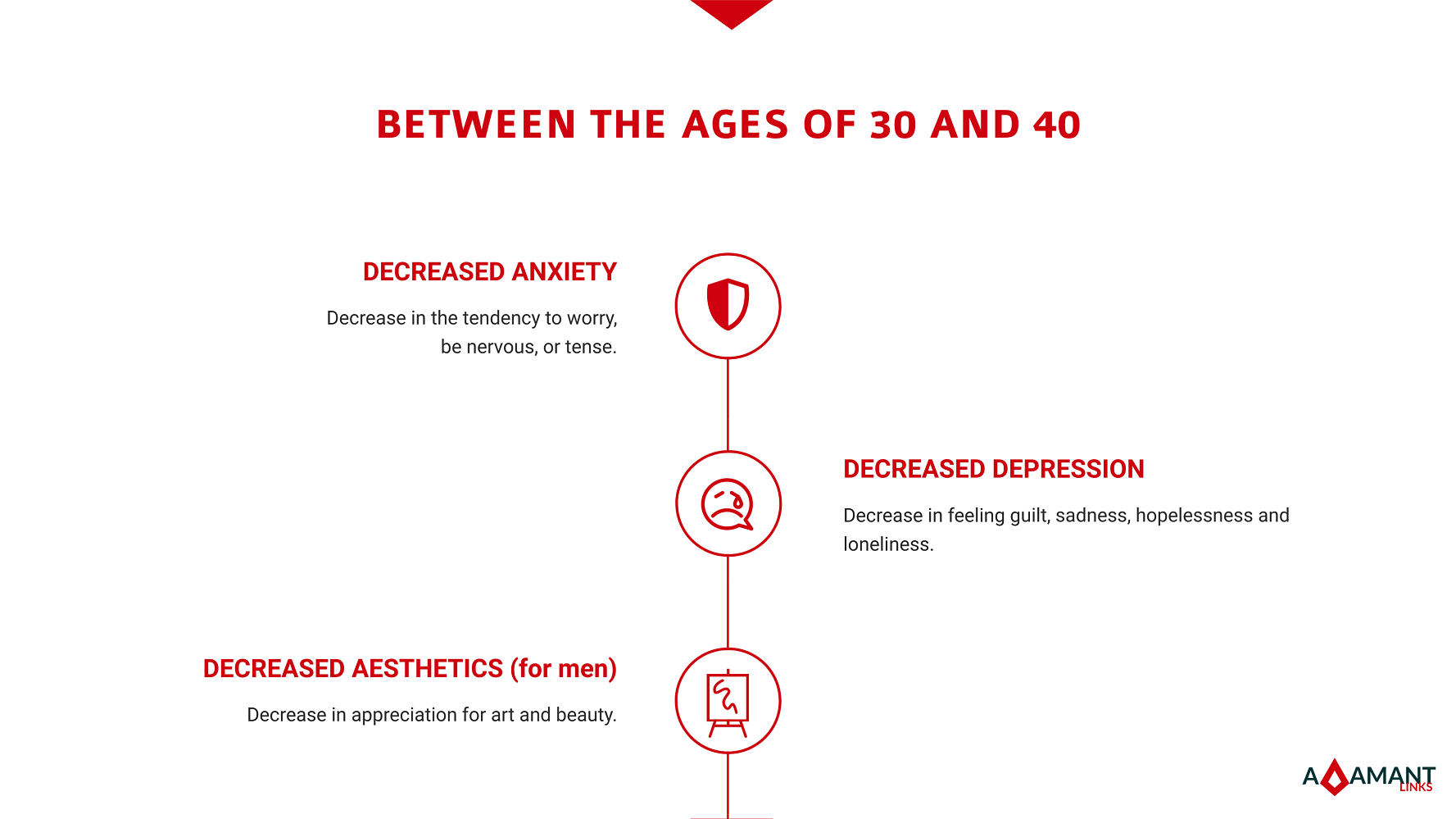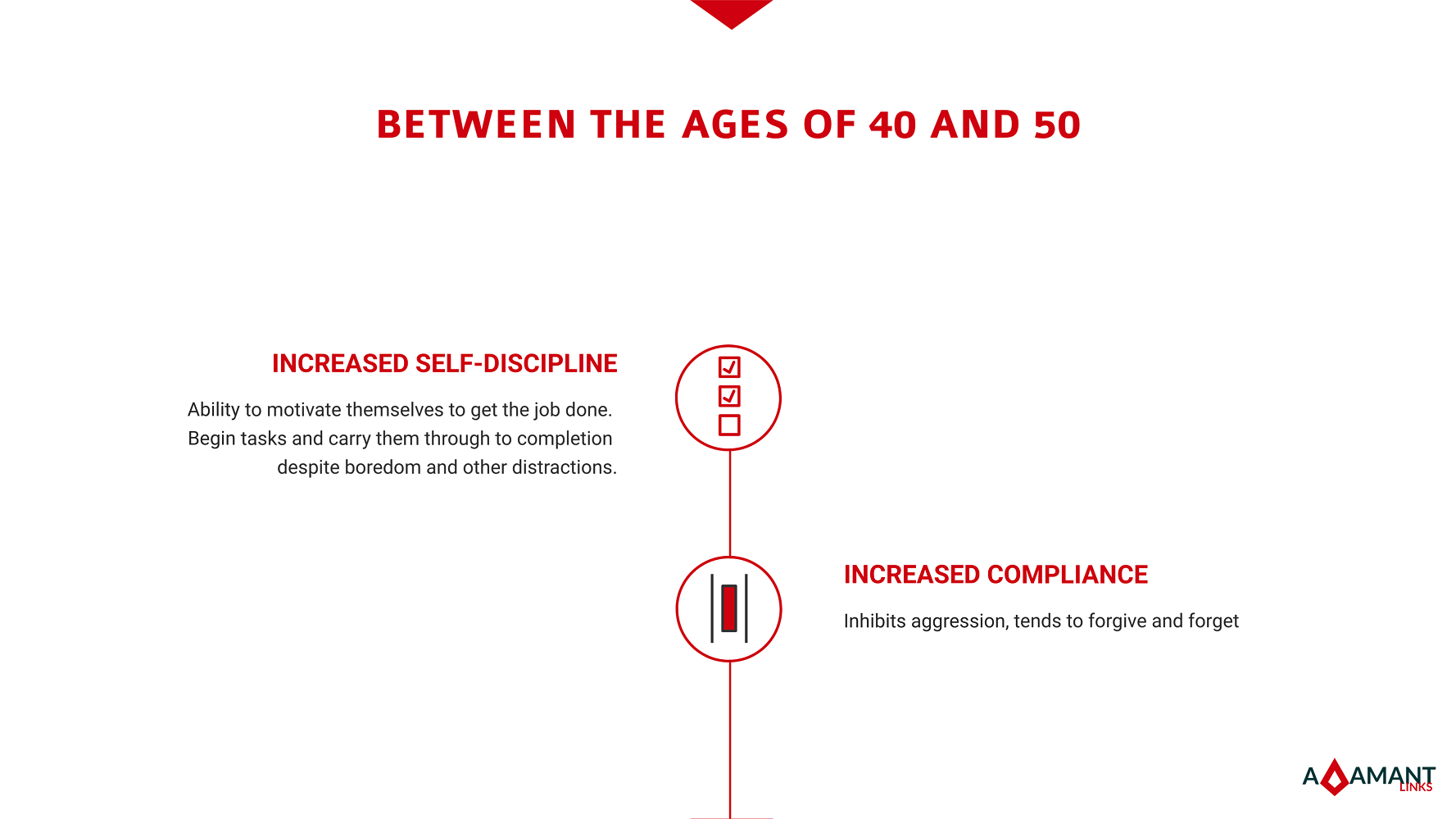by Vlad Ungureanu
Jul 2020
Key takeaways from this article!
Personality is consistent throughout a person's life, but it suffers changes and variations in intensity with age. These differences provide a great way to use psychographic segmentation in relation with age groups.
Between the ages of 20 and 30 people tend to get more disciplined and develop and increased preferences for novel and complex ideas.
Between the ages of 30 and 40 people tend to get more confident and less anxious and less depressed. Men become less interested in Aesthetics.
Between the ages of 40 and 50 personality is more stable, with needs being less likely to change. People are less likely to change, even though an increase in Compliance is observed.
Between the ages of 50 and 60 there is a noticeable decrease in Extroversion. People are less friendly and gregarious, while they keep getting more disciplined. Women score more in Aesthetics.
Psychographics and Age
With the exception of childhood (when personality takes shape), personality remains mostly constant over a person’s lifetime, with studies showing that as a person gets older, the more pronounced each dimension of the Big Five/OCEAN model gets.
For example, let’s assume that a person scores 40 on the Openness to Experience dimension in their 20’s; by the time they will be 40 years old, the score should have increase to somewhere between 50 and 60. In a similar manner someone scoring 80 in their 20 would most likely score around 90+ when they reach 50 years of age. However, the various traits/facets of each dimension have a different evolution over time, which we will discuss in details in this article.

Adamant Links - Psychographics between the ages of 20 and 30
Between 20 and 30 years old
Both men and women in this age group have a very rapid increase in scoring for the Ideas trait (curiosity, open-mindedness, willingness to consider new ideas) of Openness. In this age group, women tend to have a far greater score and a greater increase compared to men in the Self-Discipline trait of Conscientiousness (the difference remains constant for the other age groups as well). In terms of Activity (facet of Extroversion) women have a greater decrease, compared to men, although, both genders tend to reach the similar values by age 30. Almost all facets of Agreeableness suffer a decrease in scoring in this group age. Finally, for the Neuroticism dimension, while Anxiety (fearful, nervous, tense) facets decreases, the Depression (guilt, hopelessness, sadness, loneliness) facet increases, for both genders.
In terms of marketing, people in this age group are more interested in novelty. This is the period in people’s lives where they are willing to try new things, to adopt new brands, trends and habits. Everything that is hot and trendy catches their eye. Fashion and aesthetics are at their peak and looks play an important role. As representative example, iPhone usage spikes for people in this age group, peaking around age 35.

Adamant Links - Psychographics between the ages of 30 and 40
Between 30 and 40 years old
For almost all facets and dimensions of Big Five this age group presents almost no variance in scoring. This suggests that this period in people's lives is where personality is most stable. Anxiety and Depression facets of Neuroticism start a slow, but clear decrease in scoring for both men and women. Aesthetics for men suffers a decrease in score.
In terms of marketing, men become less interested in Aesthetics, which means that trends, fashion and looks start to count less in terms of preferences and purchase. However, the need for security decreases, leaving place for higher priced purchases and preferences. While fashion is no longer of very high interest, people in this age group have a more active career and as a result they value being well dressed, this being reflected in the purchase of more conservative, but higher quality clothes, shoes and accessories. Public image plays a crucial role in terms of purchasing preferences, and people in this age group tend to be driven more by a hubristic motivation.

Adamant Links - Psychographics between the ages of 40 and 50
Between 40 and 50 years old
This age group continues the trend of low variance in scoring across all facets and dimensions. The exceptions from this trend refer to Self-Discipline (facet of Conscientiousness) and Compliance (facet of Agreeableness) which significantly increase for women in this age group.
This age group is probably the most complicated to target in terms of marketing. They already have established preferences. They have a greater sense of self and their needs and are less likely to change. However, both men and female continue scoring lower in terms of Anxiety, making them prone to even more expensive purchases.
For women, social consensus becomes a great indicator for purchase preferences; keep in mind that social network usage in this group age is reduced, and other, more original and less social network dependent strategies are required to reach women in this age group. For a limited number of people, with the necessary financial situation, this age represents the period of transition from hubristic to hedonistic motivation for purchasing expensive or luxurious products and services.

Adamant Links - Psychographics between the ages of 50 and 60
Between 50 and 60 years old
Self-Discipline (facet of Conscientiousness) and Compliance (facet of Agreeableness) continue to significantly increase for women in this age group. The same is true for Aesthetics (facet of Openness) which also increases significantly for women in this age group. Overall, there is also a significant decrease in terms of Extroversion, for both genders.
In terms of marketing, this age group is represented by fulfilling purchase ambitions, as opposed to buying for personal image as seen for the previous age groups. Most expensive car brands declare the average age of their buying customers as being between 50 and 55 years. Expensive vacation and cruises, luxury brands, and luxury fashion items for women are the preferred purchases for this age group. Quality of service and ease of purchase play important roles, while directly interacting with sales people becomes a less desirable element.
References:
- "Personality Stability From Age 14 to Age 77 Years", Mathew A. Harris, Caroline E. Brett, Wendy Johnson and Ian J. Deary, 2016
- "Age Differences in Personality Traits From 10 to 65: Big Five Domains and Facets in a Large Cross-Sectional Sample", Christopher J. Soto, Oliver John, Samuel D Gosling, Jeff Potter, 2011
- "Do You See My Growth? Two Longitudinal Studies on Personality Development from Childhood to Young Adulthood from Multiple Perspectives", Ziyan Luan, Roos Hutteman,Jaap J.A. Denissen, Jens B. Asendorpf, 2016
- "Stability and Change of Personality Across the Life Course: The Impact of Age and Major Life Events on Mean-Level and Rank-Order Stability of the Big Five", Jule Specht, Boris Egloff, Stefan C Schmukle, 2011
- "Age Changes and Differences in Personality Traits and States of the Old and Very Old", Peter Martin, M. Valora Long, Leonard W. Poon, 2002
In our next article, get a detailed look at psychographics and other demographic segments:
Psychographics and Other Demographic Segments
-
Market Segmentation: Overview
FEB 2020 -
Market Segmentation: Demographics
MAR 2020 -
Market Segmentation: Geographic Location
MAR 2020 -
Big Five/OCEAN Personality Model
JUN 2020 -
Psychographic Segmentation
JUL 2020 -
Psychographics and Biological Gender
JUL 2020 -
Psychographics and Age
JUL 2020 -
Psychographics and Other Demographic Segments
JUL 2020 -
Psychographics and Individual Preferences
AUG 2020 -
Psychographics and Internal Values
AUG 2020 -
Psychographics and Shopping Motivation
AUG 2020 -
Psychographics and Social Media - Part I
AUG 2020 -
Psychographics and Social Media - Part II
SEP 2020 -
Psychographics and Persuasion - Part I
MAR 2021 -
Psychographics and Persuasion - Part II
APR 2021 -
Psychographics and Persuasion - Part III
APR 2021